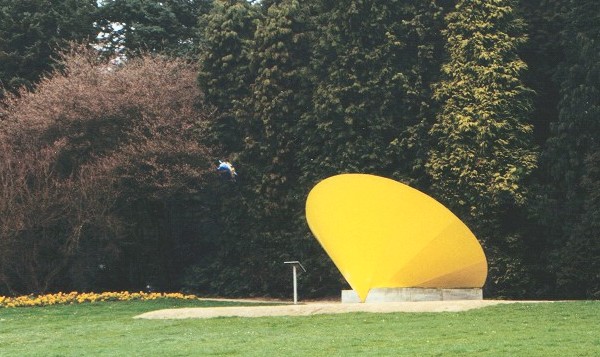
Sundial Park Genk
9. Conical sundial

This really is a novel design, and Genk has the world's first relization! The eye-catching, bright yellow cone is dominating the high side of the Park. The flying object is a balloon, by the way. These were tied to the information panels at the official opening (19 March 2000).
The shadow of the cone falls on two sets of copper hour lines, which are marked according to two historical hour systems: 'Babylonian hours' at the east side and 'Italian hours' at the west. Both types of hours are 'equal hours', which last 1/24th of a day. Babylonian hours are counted from sunrise and thus indicate how long the sun has been shining. Italian hours are counted from sunset; the Italian day thus ends (24 hr Italian time) when daylight ends. The Babylonian hour lines are labeled by yellow numbers, from 6 to 12 hr (picture at left); Italian hours are marked in blue, from 12 to 18 hr.
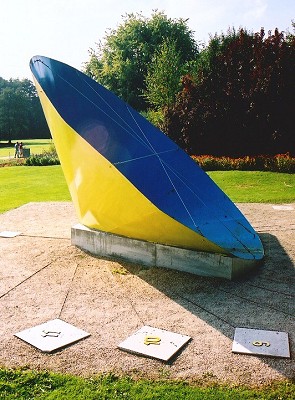 |
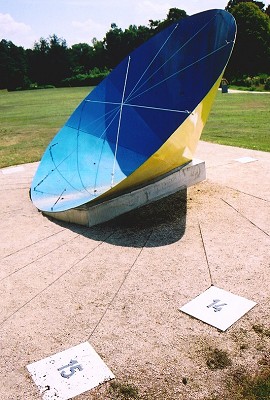 |
The axis of the cone points to the celestial pole. The angle of the cone's apex thus is 102°, twice the latitude of Genk. The edge of the cone is 2.4 m (8 ft), the diameter of the open side 3.7 m (12 ft)
The sundial has been invented by Javier Moreno Bures (Spain) in 1997.
My comments:
Principle of the conical dial
At sunrise (0 hr Babyloninan time) the sun lies exactly in the horizontal plane. The cone touches this plane along one line, where it rests on the ground. This tangent line runs north-south. The (imaginary) polar axis pierces this plane at the apex of the cone. One hour after sunrise, the plane has rotated 15° around the polar axis, and so the tangent line has rotated 15° eastward over the surface of the cone. This rotation is independent of the solar declination. The shadow of the east side of the cone would fall on the Babylonian 1 hr line.
Twelve hours later, the plane has rotated 180° and touches the southern-most side of the cone, which leans somewhat forward. The Babylonian 12 hr line thus runs exactly east-west. At that time, the sun is still rather high in the sky in summer; in winter it has set already several hours back.
A similar story applies to the Italian hours. At sunset, 24 hr Italian time, the sun lies again in the horizontal plane. One hour earlier, the tangent of the plane was still 15° more to the west and the shadow of the west side of the cone would fall on the Italian 23 hr line. Twelve hours earlier, the plane would be tangent to the southern side of the cone, so the Italian 12 hr line also runs east-west.
Note that at any moment there are two planes tangent to the cone, one corresponding with the Babylonian hours, the other with the Italian hours. As long as the sun is above the horizon, the Italian time is always higher than the Babylonean time. The difference at this latitude is about 8 hours at the summer solstice, 12 hours at the equinox and about 16 hours in winter.
Practical considerations
A cone like this one, made from sheet steel, cannot physically touch the ground along only one line. To prevent it from rolling away, it is set in a concrete bed. This covers the area where the Babylonian hour lines 1-5 and the Italian hour lines 19-23 would run.
In principle, Babylonian time could have marked here up to 16 hr and Italian time from 8 hr onwards. These hour lines would have run south from the 12 hr lines.
A charming property of Babylonian and Italian hours is that they do not need correction for the Equation of Time: that is 'built in' already!
In the above story, the sun is thought to be represented by its center. So at sunrise, half of the solar disk is above the horizontal plane. This is contrary to the usual definition of sunrise: the emergence of the upper rim of the sun.
Another factor not taken into account here, is atmospheric refraction. When we see the first glimpse of the sun, its upper rim is in fact still more than one solar diameter below the horizon.
Inverted Italian hours
An interesting variation on the Italian hour system is to take its complement from 24. This time system then counts down from 24 hr at sunset to 0 hr at the next sunset. It thus gives the time left until sunset. Clearly, the sum of the Babylonian and inverted Italian hours yields the hours of daylight.
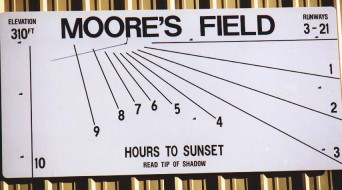 Inverted Italian hours can come in handy, even in modern society, for instance if you want to know whether you can still mow the lawn before dusk. A very nice application was made by Mac Oglesby for Moore's Field airstrip in Brattleboro (Vermont, USA). Ultra-lights are not allowed to fly after sunset, so the pilot needs to check the time left.
Inverted Italian hours can come in handy, even in modern society, for instance if you want to know whether you can still mow the lawn before dusk. A very nice application was made by Mac Oglesby for Moore's Field airstrip in Brattleboro (Vermont, USA). Ultra-lights are not allowed to fly after sunset, so the pilot needs to check the time left.
A conic section is sufficient
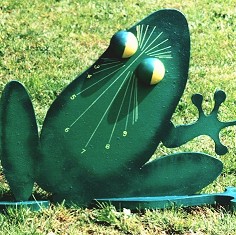 It is not necessary to have a full cone. A complete section through the cone, yielding a circle or an ellipse, will also cast a shadow on the set of hour lines, and that is sufficient to read the (Babylonian or Italian) time. Or a ball can be inserted into the cone, and when the cone is removed, the shadow of the ball will mark the hours. This idea was used by Fabio Savian (Italy) in Rana, his frog-like sundial.
It is not necessary to have a full cone. A complete section through the cone, yielding a circle or an ellipse, will also cast a shadow on the set of hour lines, and that is sufficient to read the (Babylonian or Italian) time. Or a ball can be inserted into the cone, and when the cone is removed, the shadow of the ball will mark the hours. This idea was used by Fabio Savian (Italy) in Rana, his frog-like sundial.
Relationship with horizontal dial
The cone rests on the horizontal plane and it has a polar axis. One sun, one earth, a relatively simple system. Could there be any relationship with the common horizontal pole-style dial? Yes, there is!
The Babylonian and Italian hour lines coincide with the half-hour lines of a common horizontal dial. Of course, their numbering differs. The following table summarizes these relations. Ital* = inverted Italian hours.
| Horiz. hr. | Babyl. | Italian | Ital.* |
| 4 | - | 8 | 16 |
| 6 | - | 12 | 12 |
| 8 | - | 16 | 8 |
| 10 | - | 20 | 4 |
| 12 | 0 | 24 | 0 |
| 14 | 4 | - | - |
| 16 | 8 | - | - |
| 18 | 12 | - | - |
| 20 | 16 | - | - |